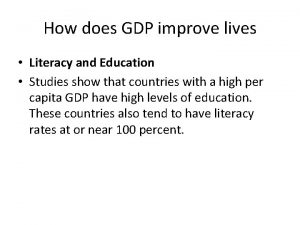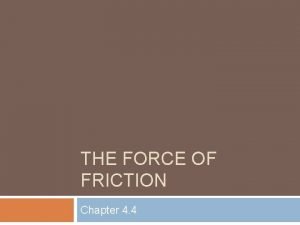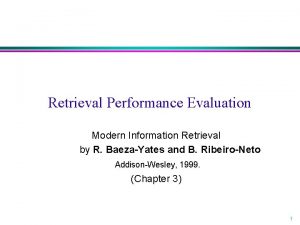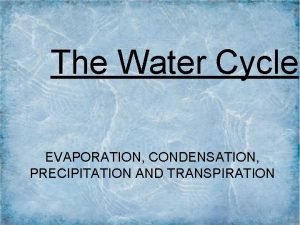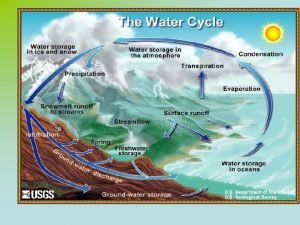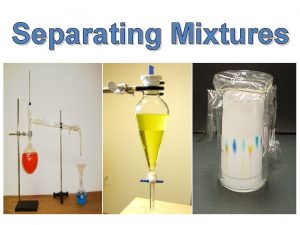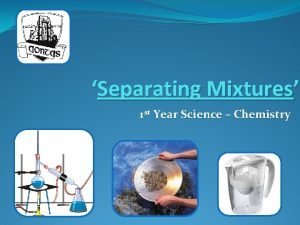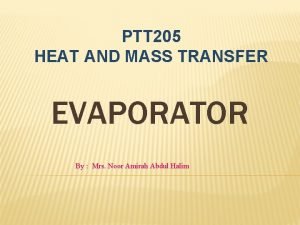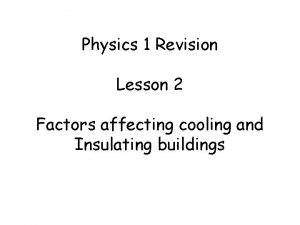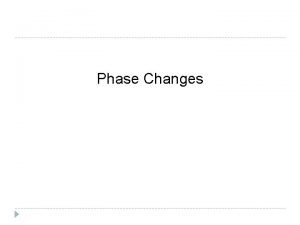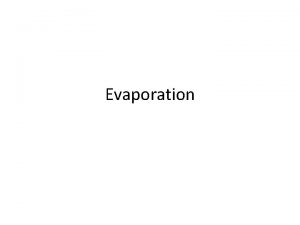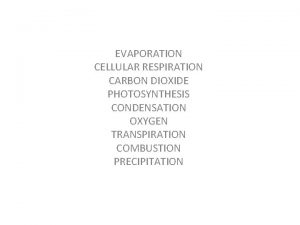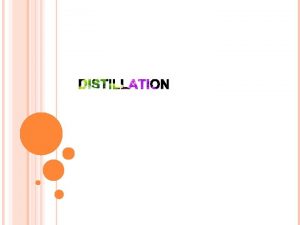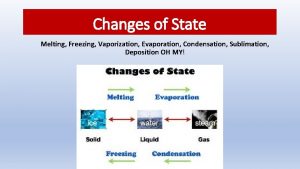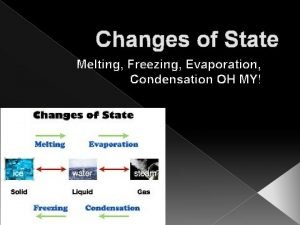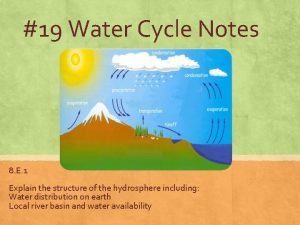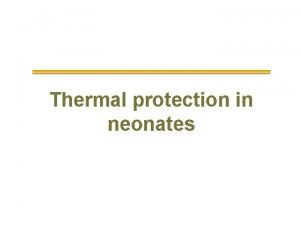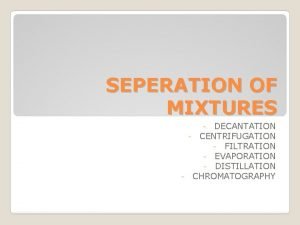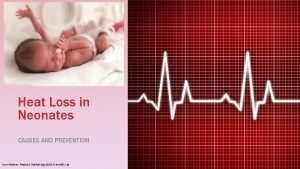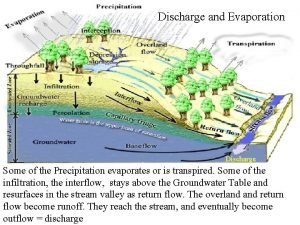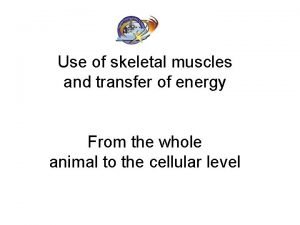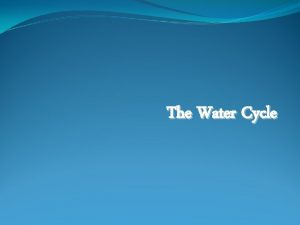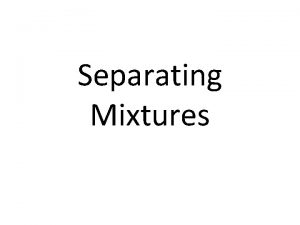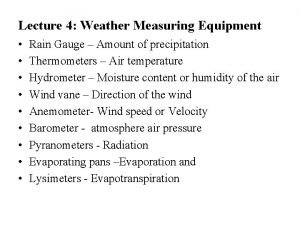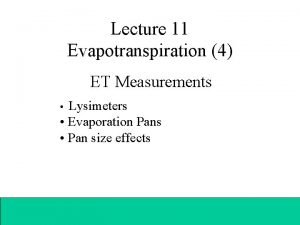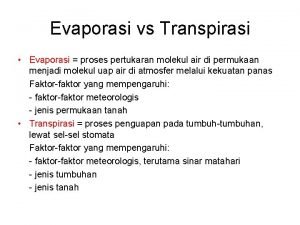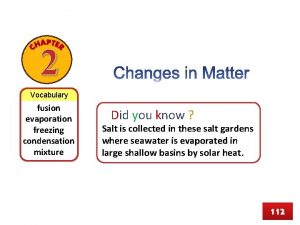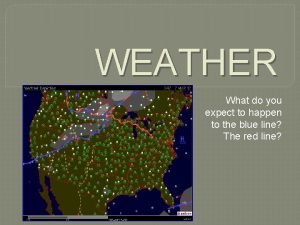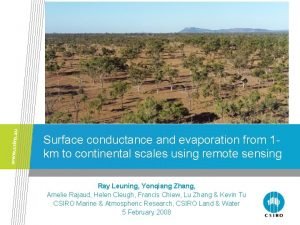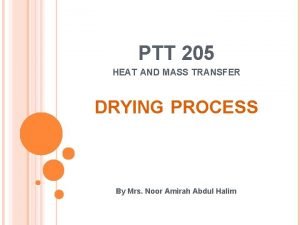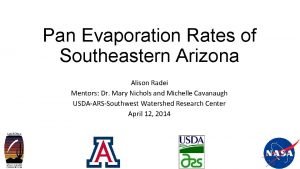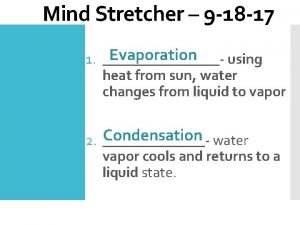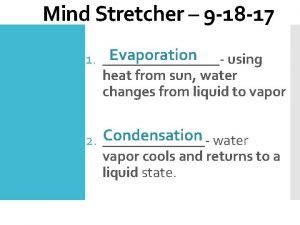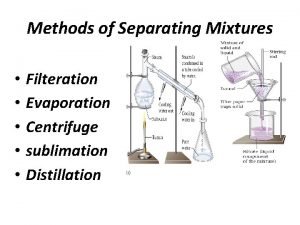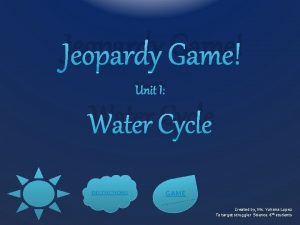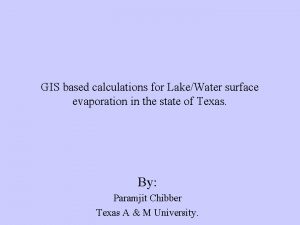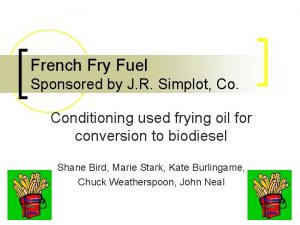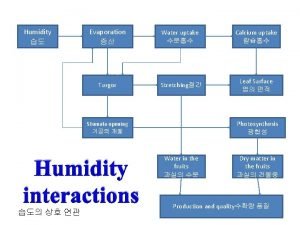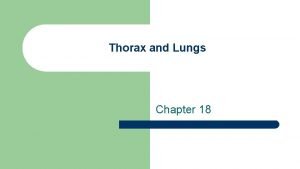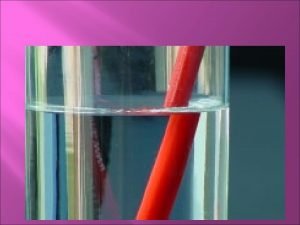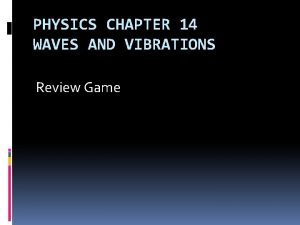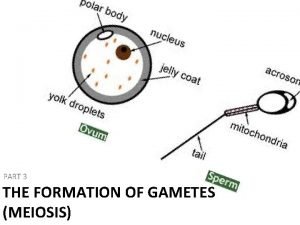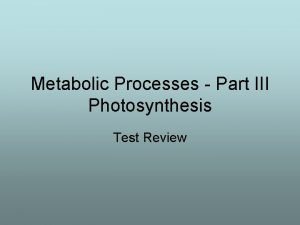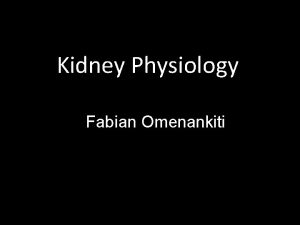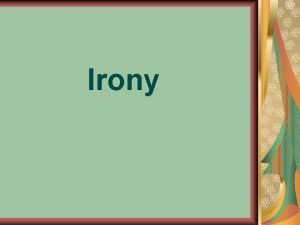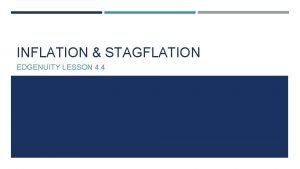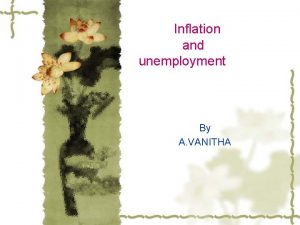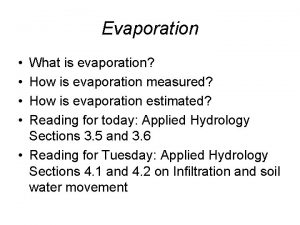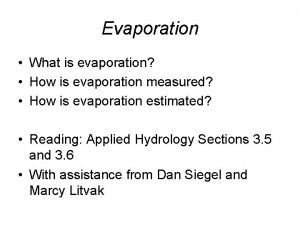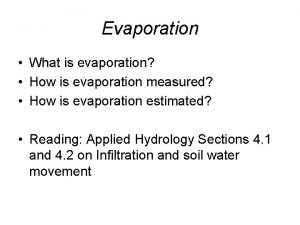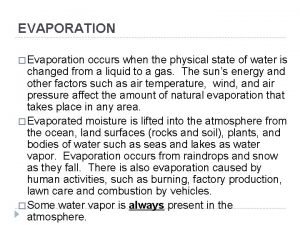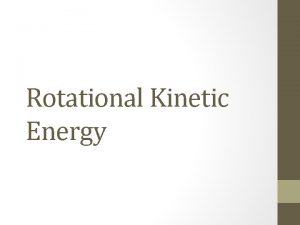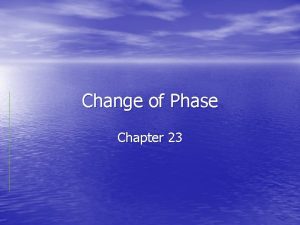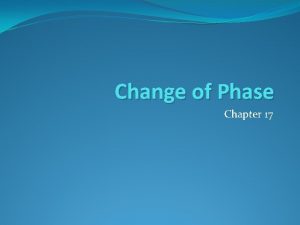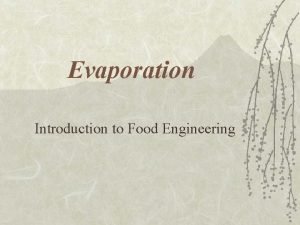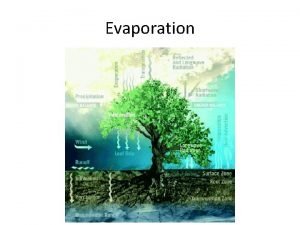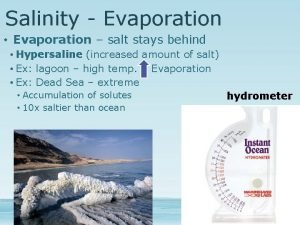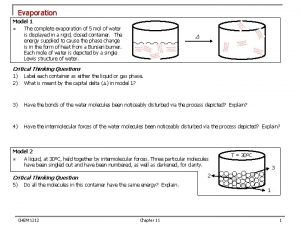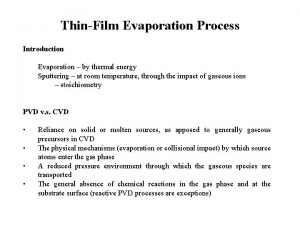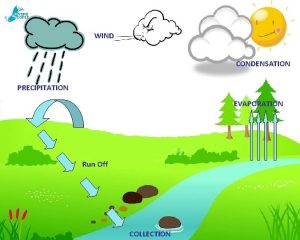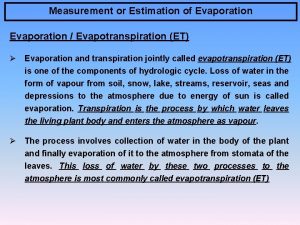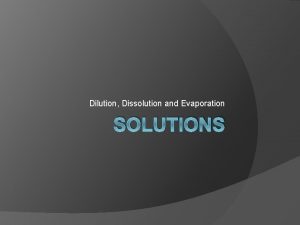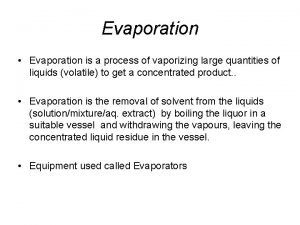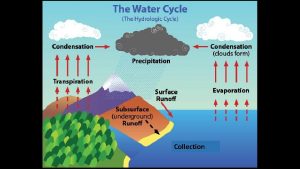Chapter 17 Evaporation Evaporation Occurs when high kinetic













































































- Slides: 77

Chapter 17

Evaporation

Evaporation • Occurs when high kinetic energy particles at the surface of a liquid break free from the attractive forces of the neighboring particles and become vapor.

Vapor • A vapor is the gaseous state of a substance that is liquid or solid under ordinary conditions.

Evaporation • Evaporation is a cooling process.

Why doesn’t evaporating water freeze?

Evaporation is a cooling process

Evaporation is a cooling process


Heat Index

Evaporation is a cooling process


Saharan Desert

Saharan Oasis

Sahara was once fertile grasslands

H 2 O(l) H 2 O(g) • Evaporation and condensation are reversible processes. • An equilibrium occurs when two opposing processes occur at the same rate.

Equilibrium H 2 O(l) H 2 O(g)

H 2 O(l) H 2 O(g) • Evaporation and condensation are reversible processes. • An equilibrium occurs when two opposing processes occur at the same rate. • At equilibrium the concentrations of the substances involved in the reaction will remain constant. • [ ] = concentration.

Equilibrium H 2 O(l) H 2 O(g)

Vapor Pressure • Suppose we conduct an experiment in which we place a quantity of ethanol (C 2 H 5 OH) in an evacuated, closed container (a). – The ethanol will quickly begin to evaporate. – The pressure exerted by the vapor will begin to increase. – After a short time the pressure will attain a constant value, called the vapor pressure of ethanol (b).

Vapor Pressure • At any given temperature, for a particular substance, there is a pressure at which the gas of that substance is in equilibrium with its liquid or solid form. This is the vapor pressure of that substance at that temperature. • The equilibrium vapor pressure is an indication of a liquid's evaporation rate. • A substance with a high vapor pressure at normal temperatures has a high rate of evaporation and is often referred to as volatile.

Attractive Forces Two types of attractive forces are: 1. Intramolecular forces 2. Intermolecular forces

Intramolecular Forces • Intramolecular forces = attractive forces that hold particles together using ionic, covalent, or metallic bonds • Intra means “within” • Intramolecular forces = bonds

Intermolecular Forces (Van der Waals forces) • Inter means “between” • Intermolecular forces are forces between molecules • Larger polar molecules have greater Van der Waals forces.

Intermolecular forces vs. Intramolecular forces

What happens when the water evaporates? • Intermolecular attractions (van der Waals forces) are broken. • Intramolecular attractions (bonds) are not broken.

alcohol vs. water How do the vapor pressures, rates of evaporation, and van der Waals forces compare? How would the boiling point of alcohol compare to water?

Why is it called rubbing alcohol?

Substances with weaker Van der Waals Forces 1. 2. 3. 4. Are easier to evaporate Have higher vapor pressure Are more volatile Have lower boiling points

Equilibrium • A state of equilibrium is the most stable state for a reversible system.

Le. Chatlier’s Principle • If a stress is placed on a system in equilibrium the system will tend to readjust so that the stress is reduced. • 3 Stresses are changing the: – Concentration – Temperature – Pressure • Le. Chatlier’s Principle = “Do the opposite”

I smell gasoline C 8 H 18(l) ↔ C 8 H 18(g)

2 NO 2(g) ↔N 2 O 4(g) brown colorless How does applying Le. Chatlier’s Principle explain that this reaction is exothermic? Rule: An increase in temperature will always shift a reaction in the endothermic direction. What other rule could we use? Note: Apply the rule, it accounts for doing the opposite. So don’t do the opposite of the rule.

H 2 O(l) H 2 O(g) Is the reaction above exothermic or endothermic?

Predict the effect of the following changes on the reaction: 2 SO 3(g) ↔ 2 SO 2 (g) + O 2 (g) ∆H = +197. 78 k. J (a) Increasing the temperature of the reaction.

Predict the effect of the following changes on the reaction: 2 SO 3(g) ↔ 2 SO 2 (g) + O 2 (g) ∆H = +197. 78 k. J (b) Increasing the pressure on the reaction.

Predict the effect of the following changes on the reaction: 2 SO 3(g) ↔ 2 SO 2 (g) + O 2 (g) ∆H = +197. 78 k. J (c) Adding more O 2.

Predict the effect of the following changes on the reaction: 2 SO 3(g) ↔ 2 SO 2 (g) + O 2 (g) ∆H = +197. 78 k. J (d) Removing O 2.

Homework Worksheet 1 Chapter 17.





Solid-Vapor Equilibrium • Sublimation is a process in which molecules go directly from the solid into the vapor phase (deposition is the reverse process).

Sublimation Iodine and dry ice are substances that commonly undergo sublimation. Which of these can reach equilibrium?

Deposition • The formation of frost.

Boiling • A substance boils when the vapor pressure of the liquid is equal to the atmospheric pressure.

How could I boil this water? A A A

What is temperature of the water? A A A

Why does water boil at 100°C?

Is there another way to boil the water?

Is there another way to boil the water?

Is there another way to boil the water?

What is the pressure inside the bell jar if the water is boiling at 20°C?

We can make water boil at “any” temperature.


≈234 Elevation = 29, 035 ft.



Volcanic Vents

• LONDON — Scientists using a remote-controlled submarine have discovered the deepest known volcanic vent and say the superheated waters inside could contain undiscovered marine species and perhaps even clues to the origin of life on earth. • Experts aboard the RRS James Cook said they found the underwater volcanic vent more than three miles (five kilometers) beneath the surface of the Caribbean. • Volcanic vents areas where sea water seeps into small cracks that penetrate deep into the earth's crust — some reaching down more than a mile (two kilometers. ) Temperatures there can reach 750 degrees Fahrenheit (400 degrees Celsius), heating the water to the point where it can melt lead. • The blazing hot mineral-rich fluid is expelled into the icy cold of the deep ocean, creating a smoke-like effect and leaving behind towering chimneys of metal ore, some two stories tall. The spectacular pressure — 500 times stronger than the earth's atmosphere — keeps the water from boiling.

Which beaker of water has had more heat added to it? Boiling for 5 minutes Boiling for 30 minutes

Which beaker of water is hotter? Boiling for 5 minutes Boiling for 30 minutes

What would happen to this water as it boiled? It gets colder

How can we continue to boil the water as it cools?

What happens when the vapor pressure of water reaches 4. 6 mm Hg.



What is the boiling point of ethanol at normal air pressure?

What is the boiling point of water at an air pressure of 400 torr? ≈82°C

At what air pressure will Diethyl ether boil at 20°C? ≈450 torr

How do these substances compare in terms of Van der Waals forces, rate of evaporation, vapor pressure, and volatility ?

How do these substances compare in terms of Van der Waals forces, rate of evaporation, vapor pressure, and volatility? Diethyl ether has the least Van der Waals forces, and the greatest rate of evaporation, vapor pressure, and volatility. Ethylene glycol has the greatest Van der Waals forces, and the lowest rate of evaporation, vapor pressure, and volatility.

“Which would you expect to have the higher boiling point?

“Which would you expect to have the higher boiling point? He = -269˚C Rn = -62˚C

Demonstrations • Boiling water with by applying hands. • Freezing water by boiling.

Homework Summarize the “Equilibrium” Lab (due tomorrow). Worksheet 1 Chapter 17 (due tomorrow). Worksheet 2 Chapter 17 (due in two days). Study Guide Chapters 15 – 17 (due in two days).
 Stagflation occurs when high inflation combines with
Stagflation occurs when high inflation combines with Chapter 5 visual 2 static and kinetic friction
Chapter 5 visual 2 static and kinetic friction High precision vs high recall
High precision vs high recall High precision vs high recall
High precision vs high recall Directive and supportive leadership
Directive and supportive leadership High expectations high support
High expectations high support Low accuracy low precision
Low accuracy low precision High directive and high supportive behavior
High directive and high supportive behavior High risk high return artinya
High risk high return artinya Condensation evaporation precipitation
Condensation evaporation precipitation The process of evaporation from plants is called
The process of evaporation from plants is called Filtration used to separate
Filtration used to separate Filtration separating mixtures examples
Filtration separating mixtures examples How to separate salt and sand chemistry
How to separate salt and sand chemistry Evaporation heat transfer
Evaporation heat transfer Factors affecting rate of cooling
Factors affecting rate of cooling Examples of phase change
Examples of phase change Objectives of evaporation
Objectives of evaporation Water
Water Is cellular respiration
Is cellular respiration Applications of distillation
Applications of distillation Melting evaporation condensation freezing
Melting evaporation condensation freezing Freezing melting evaporation condensation
Freezing melting evaporation condensation Water cycle and transpiration
Water cycle and transpiration Evaporative heat loss newborn
Evaporative heat loss newborn Decantation distillation
Decantation distillation Metal evaporation
Metal evaporation Heat loss in babies
Heat loss in babies Evaporation
Evaporation Kinetic particle model
Kinetic particle model Evaporation
Evaporation Transpirasi yaitu penguapan air
Transpirasi yaitu penguapan air Evaporation water cycle
Evaporation water cycle Boiler efficiency calculation
Boiler efficiency calculation Evaporation separating mixtures examples
Evaporation separating mixtures examples Evaporation pan
Evaporation pan Evapotranspiration
Evapotranspiration Proses gabungan antara evaporasi dan transpirasi
Proses gabungan antara evaporasi dan transpirasi Sublimation evaporation
Sublimation evaporation Fusion evaporation condensation
Fusion evaporation condensation What is evaporation
What is evaporation Evaporation
Evaporation Evaporation
Evaporation Remanence def
Remanence def Tray dryer calculations
Tray dryer calculations Evaporation
Evaporation Thermal evaporation
Thermal evaporation Prep 1
Prep 1 Evaporation mind map
Evaporation mind map Evaporation
Evaporation Evaporation
Evaporation Evaporation
Evaporation Evaporation
Evaporation Application of evaporation
Application of evaporation Flash evaporation
Flash evaporation Humidity evaporation
Humidity evaporation What is the force distance trade off
What is the force distance trade off What is incident report form
What is incident report form Tactile fremitus increased
Tactile fremitus increased Stoichiometry predicting amounts in reactions
Stoichiometry predicting amounts in reactions Stimulus control occurs when
Stimulus control occurs when Gas exchange oxygen transport
Gas exchange oxygen transport Snell's law
Snell's law _____ occurs when waves bend around a barrier.
_____ occurs when waves bend around a barrier. Etc occurs in
Etc occurs in Crossing over occurs during:
Crossing over occurs during: Saltatory conduction occurs in
Saltatory conduction occurs in Independent assortment of chromosomes
Independent assortment of chromosomes Metallic bonds occur between atoms of
Metallic bonds occur between atoms of Photorespiration occurs principally because of
Photorespiration occurs principally because of The science duo
The science duo Lagging strand
Lagging strand Reabsorption in the nephron occurs in the
Reabsorption in the nephron occurs in the Dramatic irony definition
Dramatic irony definition An interaction occurs whenever the
An interaction occurs whenever the Typically high inflation is a sign of
Typically high inflation is a sign of Costs of inflation
Costs of inflation Types of unemployments
Types of unemployments
